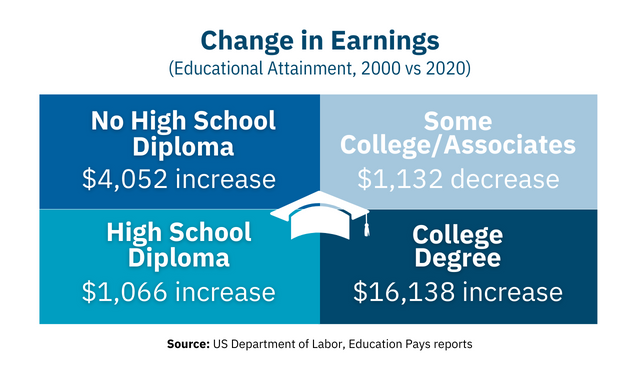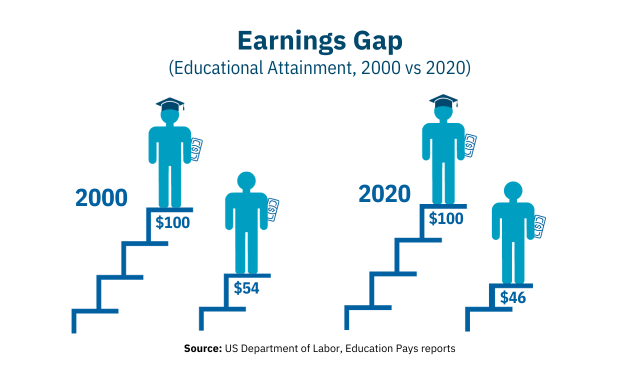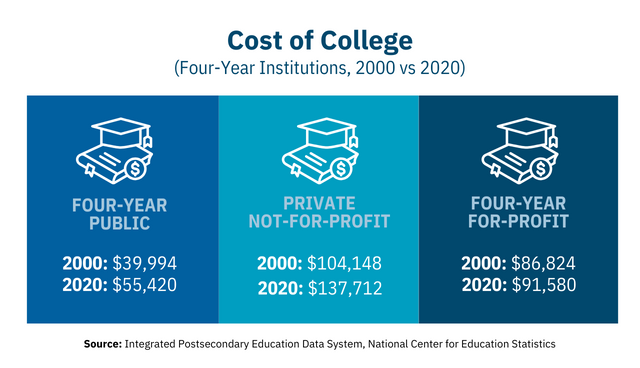
Then and Now: The Changing Landscape of Education Outcomes and Funding in the 21st Century
Nyerere Hodge, Stuart Andreason, and Carl E. Van Horn
October 15, 2024
2024-03
https://doi.org/10.29338/wc2024-03
Download the full text of this paper (1,246 KB)
This is the final installment of a three-part series which brings together labor market, workforce, occupational, and educational trends since 2000 to tell a story of the American worker through data. Part three looks at wage disparities between workers with and without college degrees, and the rising costs of higher education.
The "Then and Now" series explores data broadly and granularly with a demographic lens, recognizing that general trends often are not experienced universally across groups. We identify where opportunities for some workers have improved and where there may be a need for additional efforts to increase opportunities for enhanced economic mobility.
This is a story told primarily through charts and tables to serve as an illustration of how workers are experiencing the labor market. We bring together two decades of data and hope this informs workforce practitioners, policymakers, business leaders, and others as they double down in areas where the trends show positive signs of improvement and continue as change agents in areas where the trends are stagnant or regressing.
The three parts of this series are as follows:
- Earnings
- Labor Force Participation
- Unemployment
- Educational Attainment
Part 1: Key Trends and Transformations in the 21st Century Labor Market
- Unemployment Insurance
- Unemployment Spells
- Health Insurance Coverage
- Retirement Benefits
Part 2: The Evolution of Key Worker Support Systems in the 21st Century
- Earnings by Educational Attainment
- College/University Tuition
- Higher Education Grants and Loans
- Funding at Historically Black Colleges and Universities and Tribal Colleges and Universities
Part 3: The Changing Landscape of Education Outcomes and Funding in the 21st Century
Part three highlights the increasing earnings disparity between workers with and without a college degree. We trace tuition increases over the last two decades, as well as, how grant aid and student loan reliance changed in conjunction. We also highlight some of the ways in which historically Black colleges and universities (HBCUs) and tribal colleges and universities (TCUs) are underfunded.
Part one looked at big labor market trends. We explored how median earnings changed over time and whether they kept up with inflation. We illustrated labor force participation and unemployment trends. We also explored whether society’s push for higher education benefited all workers. We explored these trends in the aggregate to understand the country’s direction as a whole, but also with a demographic lens to identify where action can be taken to support different groups of workers, ultimately to better support an economy that works for all.
Part two reviewed the uptake of unemployment insurance over the last two decades and the affect pandemic-era policy had on coverage. It also looked at an attempt to expand health care coverage and a retirement policy that some research suggests shifted the way Americans save for retirement.
Here we excerpt some of the key findings from "Then and Now: The Changing Landscape of Education Outcomes and Funding in the 21st Century."
The infographic below illustrates the growing disparity between workers with and without a college degree. From 2000 to 2020, inflation-adjusted median earnings for workers with a college degree increased by $16,138; for workers with at least some college credits it decreased by $1,132; for workers with a high school diploma it increased by $1,066; and for workers without a high school diploma the inflation-adjusted median earnings increased by $4,052.

In 2000, the median wage earner without a college degree earned $54 for every $100 a college graduate earned in 2000—by 2020, that shrunk to $46 per $100.

As earnings increased for college graduates, tuition also increased over the same period. The average cost of four years of attendance at a four-year public institution increased from $39,944 in 2000 to $55,420 in 2020; at private not-for-profit institutions it increased from $104,148 to $137,712; and at private for-profit institutions it increased from $86,824 to $91,580. These costs do not include other expenses like books, supplies, room and board, food, childcare, health care, and transportation.

The full report also lays out how grant aid and student loan reliance changed over this period as well. It disaggregates this data showing trends for HBCUs and TCUs and ends with a note on funding at these institutions.
Nyerere "Nye" Hodge is a senior research analyst for community and economic development in the Atlanta Fed's Center for Workforce and Economic Opportunity. Stuart Andreason is managing director of workforce Innovation at the Burning Glass Institute. Carl Van Horn is distinguished professor of public policy at Rutgers University and director of the Heldrich Center for Workforce Development at Rutgers.


